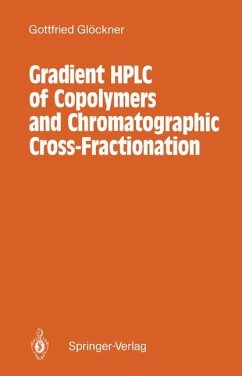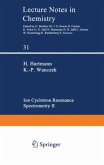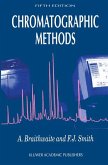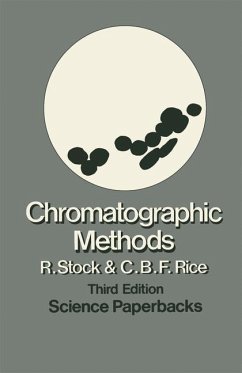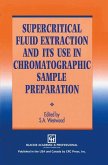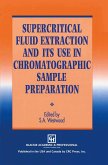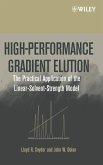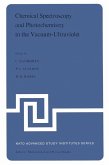Gottfried Glöckner
Gradient HPLC of Copolymers and Chromatographic Cross-Fractionation
Gottfried Glöckner
Gradient HPLC of Copolymers and Chromatographic Cross-Fractionation
- Broschiertes Buch
- Merkliste
- Auf die Merkliste
- Bewerten Bewerten
- Teilen
- Produkt teilen
- Produkterinnerung
- Produkterinnerung
"The problems involved in separating complex macromolecules require under standing not only the chromatographic process but also the physicochemical behavior of the solutes." This sentence from the pen of Phyllis R. Brown 1, University of Rhode Island, can certainly be applied to synthetic copolymers whose structure is very complex indeed. Thus it may be forgiven that a book on copolymer HPLC has been written not by a trained chromatographer but by someone from the polymer side. The HPLC of synthetic polymers is often understood to mean only a synonym for size exclusion chromatography. The…mehr
Andere Kunden interessierten sich auch für
![Ion Cyclotron Resonance Spectrometry II Ion Cyclotron Resonance Spectrometry II]() Ion Cyclotron Resonance Spectrometry II39,99 €
Ion Cyclotron Resonance Spectrometry II39,99 €![Chromatographic Methods Chromatographic Methods]() A. BraithwaiteChromatographic Methods139,99 €
A. BraithwaiteChromatographic Methods139,99 €![Chromatographic Methods Chromatographic Methods]() R. StockChromatographic Methods39,99 €
R. StockChromatographic Methods39,99 €![Supercritical Fluid Extraction and its Use in Chromatographic Sample Preparation Supercritical Fluid Extraction and its Use in Chromatographic Sample Preparation]() Supercritical Fluid Extraction and its Use in Chromatographic Sample Preparation110,99 €
Supercritical Fluid Extraction and its Use in Chromatographic Sample Preparation110,99 €![Supercritical Fluid Extraction and Its Use in Chromatographic Sample Preparation Supercritical Fluid Extraction and Its Use in Chromatographic Sample Preparation]() WestwoodSupercritical Fluid Extraction and Its Use in Chromatographic Sample Preparation179,99 €
WestwoodSupercritical Fluid Extraction and Its Use in Chromatographic Sample Preparation179,99 €![High-Performance Gradient Elution High-Performance Gradient Elution]() Lloyd R. SnyderHigh-Performance Gradient Elution200,99 €
Lloyd R. SnyderHigh-Performance Gradient Elution200,99 €![Chemical Spectroscopy and Photochemistry in the Vacuum-Ultraviolet Chemical Spectroscopy and Photochemistry in the Vacuum-Ultraviolet]() Chemical Spectroscopy and Photochemistry in the Vacuum-Ultraviolet39,99 €
Chemical Spectroscopy and Photochemistry in the Vacuum-Ultraviolet39,99 €-
-
-
"The problems involved in separating complex macromolecules require under standing not only the chromatographic process but also the physicochemical behavior of the solutes." This sentence from the pen of Phyllis R. Brown 1, University of Rhode Island, can certainly be applied to synthetic copolymers whose structure is very complex indeed. Thus it may be forgiven that a book on copolymer HPLC has been written not by a trained chromatographer but by someone from the polymer side. The HPLC of synthetic polymers is often understood to mean only a synonym for size exclusion chromatography. The latter method separates polymers according to the size of the macromolecules and enables the molecular weight distribution of a sample to be evaluated. But as early as 1936, Mark and Saito attempted chromatographic fractionation of cellulose acetate on a charcoal-like adsorbent made from blood. HPLC adsorption chromatography was first applied to copolymer analysis by Teramachi et al. in 1979. Since then, another branch of polymer HPLC has arisen which has the capacity of separating copolymers by composition and enables the chemical composition distribution to be evaluated. The technique requires a suitable elution program and is mainly carried out as gradient elution.
Produktdetails
- Produktdetails
- Verlag: Springer / Springer Berlin Heidelberg / Springer, Berlin
- Artikelnr. des Verlages: 978-3-642-75801-0
- Softcover reprint of the original 1st ed. 1991
- Seitenzahl: 232
- Erscheinungstermin: 23. Februar 2012
- Englisch
- Abmessung: 235mm x 155mm x 13mm
- Gewicht: 358g
- ISBN-13: 9783642758010
- ISBN-10: 3642758010
- Artikelnr.: 36121109
- Verlag: Springer / Springer Berlin Heidelberg / Springer, Berlin
- Artikelnr. des Verlages: 978-3-642-75801-0
- Softcover reprint of the original 1st ed. 1991
- Seitenzahl: 232
- Erscheinungstermin: 23. Februar 2012
- Englisch
- Abmessung: 235mm x 155mm x 13mm
- Gewicht: 358g
- ISBN-13: 9783642758010
- ISBN-10: 3642758010
- Artikelnr.: 36121109
1 Introduction.- 1.1 About the Aims and Methods of Cross Fractionation.- 1.2 Classical Cross-Fractionation.- 1.3 Cross Fractionation Including Size Exclusion Chromatography.- 1.3.1 SEC Analysis of Fractions Obtained by Precipitation or Extraction.- 1.3.2 Preparative Thin-Layer Chromatography and SEC Analysis of the Fractions.- 1.3.3 Preparative SEC and TLC Analysis of the Fractions.- 1.4 Cross Fractionation by Coupled SEC Techniques.- 1.5 Elution Under Critical Conditions.- 1.6 References.- 2 Chemical Heterogeneity of Copolymers.- 2.1 Sequence Distribution.- 2.2 Instantaneous Heterogeneity.- 2.3 Modification of the Stockmayer Distribution.- 2.4 Conversion Heterogeneity.- 2.5 References.- 3 Size Exclusion Liquid Chromatography of Copolymers.- 3.1 Universal Calibration.- 3.2 Secondary Exclusion and Adsorption Effects.- 3.3 Detector Response.- 3.4 Fractionation by Hydrodynamic Volume.- 3.5 References.- 4 Special Features of Polymer HPLC.- 4.1 Diffusion Coefficients of Macromolecules in Solution.- 4.2 Stokes Radii and Hydrodynamic Dimensions of Macromolecules.- 4.3 Retention by Multiple Attachment.- 4.4 Conformation of Synthetic Polymers.- 4.5 Solubility of Polymers.- 4.6 Gradient Elution of Polymers.- 4.7 Gradient Elution of Polymers on Small Pore Packings.- 4.8 The Martin Equation.- 4.9 Effect of Block Structure on Retention.- 4.10 References.- 5 Solubility and Adsorption Effects in Polymer HPLC.- 5.1 Dependence of Retention Time on Sample Size.- 5.2 Comparison Between Solubility and Elution Characteristics...- 5.3 Correspondence Between Column Polarity and Gradient Orientation.- 5.4 Effect of Temperature.- 5.5 High-Performance Precipitation Liquid Chromatography.- 5.6 Normal-Phase Gradient Elution with Separate Adjustment of Polarity and Solvent Strength.- 5.7 References.- 6 Effect of Mobile and Stationary Phase in Polymer HPLC.- 6.1 Elution in the Critical Region.- 6.2 The Role of the Stationary Phase.- 6.3 Normal and Reversed Phase HPLC of Polymers.- 6.4 References.- 7 Detection in Gradient High-Performance Liquid Chromatography.- 7.1 Selective Detectors.- 7.2 Detection Subsequent to Eluent Vaporization.- 7.3 References.- 8 Quantitative Evaluation and Calibration.- 8.1 Features of a Proper Run in Polymer HPLC.- 8.2 Quantitative Evaluation.- 8.3 Incomplete Retention and Elution.- 8.4 Signal Enhancement by Turbidity.- 8.5 Calibration of Polymer Gradient HPLC.- 8.6 References.- 9 Separation of Copolymers by Composition through Gradient High-Performance Liquid Chromatography.- 9.1 Statistical Copolymers from Styrene and Acrylonitrile.- 9.2 Statistical Copolymers from Styrene and Methyl Acrylate.- 9.3 Copolymers from Styrene and Methyl Methacrylate.- 9.4 Statistical Copolymers from Styrene and Ethyl Acrylate.- 9.5 Statistical Copolymers from Styrene and Ethyl Methacrylate..- 9.6 Copolymers from Styrene and t-Butyl Methacrylate.- 9.7 Alkyl Methacrylates and Acrylates with Different Side Groups.- 9.8 Copolymers from Methyl Methacrylate and Methyl Acrylate..- 9.9 Copolymers from Styrene and 2-Methoxyethyl Methacrylate...- 9.10 Copolymers of Styrene and Butadiene.- 9.11 Copolymers of Decyl Methacrylate and Methyl Methacrylate..- 9.12 Graft Copolymers of Methyl Methacrylate onto Copoly (Ethylene/Propylene/Diene Monomer) (EPDM).- 9.13 Epoxy Composite Formulations, Phenol-Formaldehyde Prepolymers, Macromonomers, and Telechelic Prepolymers.- 9.14 Ethylene/?-Olefm Copolymers.- 9.15 Copolymers of Styrene and Acrylic Acid.- 9.16 Separation of PMMA Isomers.- 9.17 References.- 10 Chromatographic Cross-Fractionation.- 10.1 Scope of this Chapter.- 10.2Comparison of Calculated and Measured Curves of Chemical Composition Distribution.- 10.3 Chromatographic Cross-Fractionation of Model Mixtures 151 10.3.1 Model Mixtures of stat-Copoly(Styrene/Acrylonitrile).- 10.4 Chromatographic Cross-Fractionation of Real Copolymers...- 10.5 Cross Fractionation by Temperature-Rising Elution Fractionation and SEC Analysis of the Fractions.- 10.6 Chromatographic Cross-Fractionation of Graft Copolymers of Methyl Methacrylate onto Copoly(Ethylene/Propylene/Diene Monomer) (EPDM Rubber).- 10.7 Chromatographic Cross-Fractionation of Styrene/Vinyl Acetate Block Copolymers.- 10.8 References.- 11 Experimental Problems.- 11.1 THF as a Mobile Phase.- 11.2 Sample Solvent.- 11.3 Ghost Peaks.- 11.4 Sample Load and Column Blocking.- 11.5 Hazards Caused by Incompatible Sample Polymers.- 11.6 Column Flushing.- 11.7 Effect of Column Length.- 11.8 Peak Splitting.- 11.9 Column Conditioning by Sample Injection.- 11.10 Guidelines for Selecting Suitable Phase Systems for Copolymer HPLC.- 11.11 References.- 12 Glossary of Terms.- Author Index.
1 Introduction.- 1.1 About the Aims and Methods of Cross Fractionation.- 1.2 Classical Cross-Fractionation.- 1.3 Cross Fractionation Including Size Exclusion Chromatography.- 1.3.1 SEC Analysis of Fractions Obtained by Precipitation or Extraction.- 1.3.2 Preparative Thin-Layer Chromatography and SEC Analysis of the Fractions.- 1.3.3 Preparative SEC and TLC Analysis of the Fractions.- 1.4 Cross Fractionation by Coupled SEC Techniques.- 1.5 Elution Under Critical Conditions.- 1.6 References.- 2 Chemical Heterogeneity of Copolymers.- 2.1 Sequence Distribution.- 2.2 Instantaneous Heterogeneity.- 2.3 Modification of the Stockmayer Distribution.- 2.4 Conversion Heterogeneity.- 2.5 References.- 3 Size Exclusion Liquid Chromatography of Copolymers.- 3.1 Universal Calibration.- 3.2 Secondary Exclusion and Adsorption Effects.- 3.3 Detector Response.- 3.4 Fractionation by Hydrodynamic Volume.- 3.5 References.- 4 Special Features of Polymer HPLC.- 4.1 Diffusion Coefficients of Macromolecules in Solution.- 4.2 Stokes Radii and Hydrodynamic Dimensions of Macromolecules.- 4.3 Retention by Multiple Attachment.- 4.4 Conformation of Synthetic Polymers.- 4.5 Solubility of Polymers.- 4.6 Gradient Elution of Polymers.- 4.7 Gradient Elution of Polymers on Small Pore Packings.- 4.8 The Martin Equation.- 4.9 Effect of Block Structure on Retention.- 4.10 References.- 5 Solubility and Adsorption Effects in Polymer HPLC.- 5.1 Dependence of Retention Time on Sample Size.- 5.2 Comparison Between Solubility and Elution Characteristics...- 5.3 Correspondence Between Column Polarity and Gradient Orientation.- 5.4 Effect of Temperature.- 5.5 High-Performance Precipitation Liquid Chromatography.- 5.6 Normal-Phase Gradient Elution with Separate Adjustment of Polarity and Solvent Strength.- 5.7 References.- 6 Effect of Mobile and Stationary Phase in Polymer HPLC.- 6.1 Elution in the Critical Region.- 6.2 The Role of the Stationary Phase.- 6.3 Normal and Reversed Phase HPLC of Polymers.- 6.4 References.- 7 Detection in Gradient High-Performance Liquid Chromatography.- 7.1 Selective Detectors.- 7.2 Detection Subsequent to Eluent Vaporization.- 7.3 References.- 8 Quantitative Evaluation and Calibration.- 8.1 Features of a Proper Run in Polymer HPLC.- 8.2 Quantitative Evaluation.- 8.3 Incomplete Retention and Elution.- 8.4 Signal Enhancement by Turbidity.- 8.5 Calibration of Polymer Gradient HPLC.- 8.6 References.- 9 Separation of Copolymers by Composition through Gradient High-Performance Liquid Chromatography.- 9.1 Statistical Copolymers from Styrene and Acrylonitrile.- 9.2 Statistical Copolymers from Styrene and Methyl Acrylate.- 9.3 Copolymers from Styrene and Methyl Methacrylate.- 9.4 Statistical Copolymers from Styrene and Ethyl Acrylate.- 9.5 Statistical Copolymers from Styrene and Ethyl Methacrylate..- 9.6 Copolymers from Styrene and t-Butyl Methacrylate.- 9.7 Alkyl Methacrylates and Acrylates with Different Side Groups.- 9.8 Copolymers from Methyl Methacrylate and Methyl Acrylate..- 9.9 Copolymers from Styrene and 2-Methoxyethyl Methacrylate...- 9.10 Copolymers of Styrene and Butadiene.- 9.11 Copolymers of Decyl Methacrylate and Methyl Methacrylate..- 9.12 Graft Copolymers of Methyl Methacrylate onto Copoly (Ethylene/Propylene/Diene Monomer) (EPDM).- 9.13 Epoxy Composite Formulations, Phenol-Formaldehyde Prepolymers, Macromonomers, and Telechelic Prepolymers.- 9.14 Ethylene/?-Olefm Copolymers.- 9.15 Copolymers of Styrene and Acrylic Acid.- 9.16 Separation of PMMA Isomers.- 9.17 References.- 10 Chromatographic Cross-Fractionation.- 10.1 Scope of this Chapter.- 10.2Comparison of Calculated and Measured Curves of Chemical Composition Distribution.- 10.3 Chromatographic Cross-Fractionation of Model Mixtures 151 10.3.1 Model Mixtures of stat-Copoly(Styrene/Acrylonitrile).- 10.4 Chromatographic Cross-Fractionation of Real Copolymers...- 10.5 Cross Fractionation by Temperature-Rising Elution Fractionation and SEC Analysis of the Fractions.- 10.6 Chromatographic Cross-Fractionation of Graft Copolymers of Methyl Methacrylate onto Copoly(Ethylene/Propylene/Diene Monomer) (EPDM Rubber).- 10.7 Chromatographic Cross-Fractionation of Styrene/Vinyl Acetate Block Copolymers.- 10.8 References.- 11 Experimental Problems.- 11.1 THF as a Mobile Phase.- 11.2 Sample Solvent.- 11.3 Ghost Peaks.- 11.4 Sample Load and Column Blocking.- 11.5 Hazards Caused by Incompatible Sample Polymers.- 11.6 Column Flushing.- 11.7 Effect of Column Length.- 11.8 Peak Splitting.- 11.9 Column Conditioning by Sample Injection.- 11.10 Guidelines for Selecting Suitable Phase Systems for Copolymer HPLC.- 11.11 References.- 12 Glossary of Terms.- Author Index.

